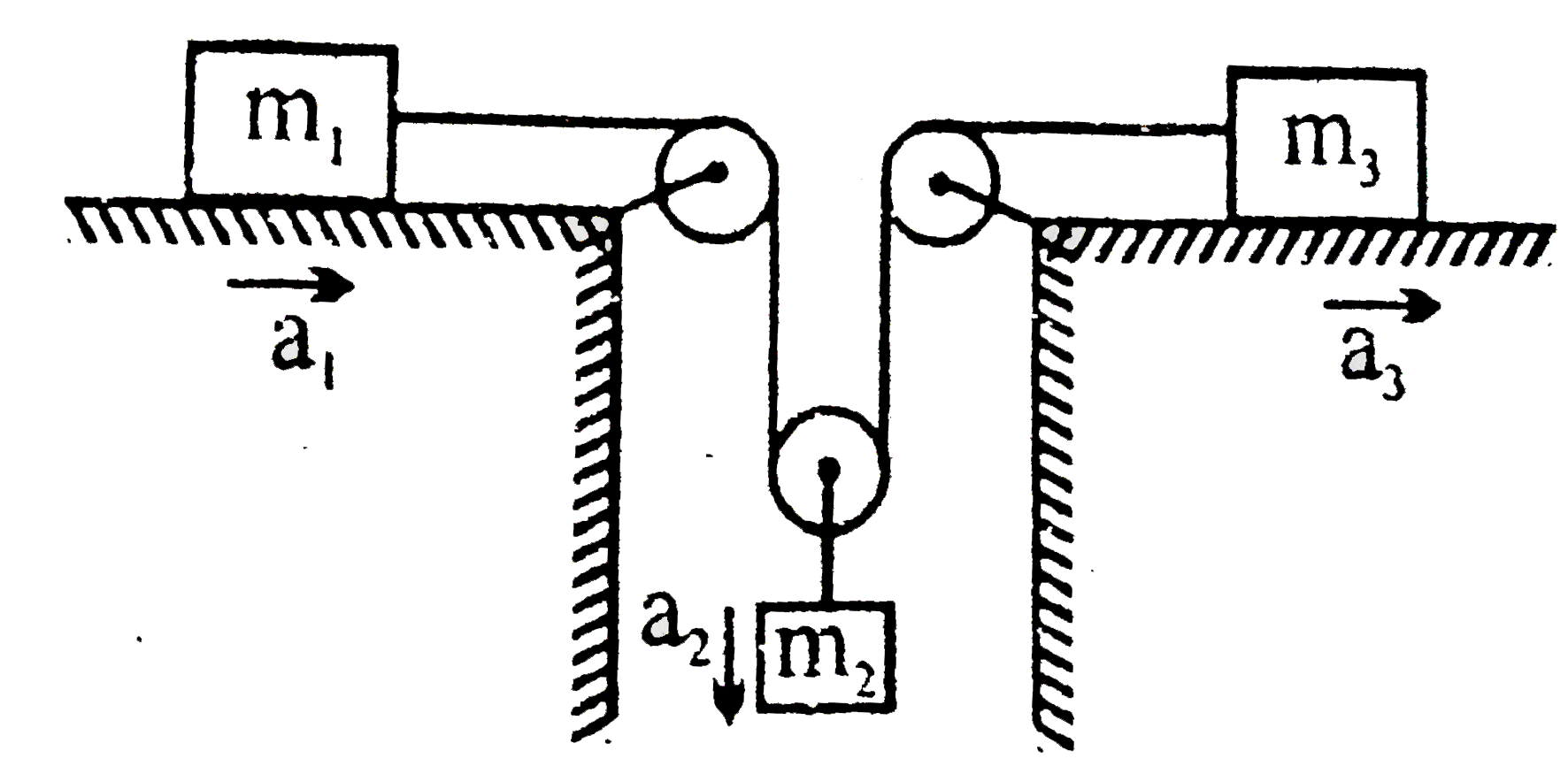In the system shown in fig. m1>m2 . The system is held at rest by thread BC. Now thread BC is burnt. Answer the following:

Just after burning the thread, what is the acceleration of m2?
(m2−m1m2)g
(m1−m2m1+m2)g
Zero
(m1−m2m2)g
The correct Answer is:D
Before Burning BC, the free-body diagram are shown in the fig.

T2=T1+m2g …(i)
kx=T2=m1g..(ii)
where x is extension in the spring. Just after burning, T1 will become zero. but T2 will remain same.
T2−m2g=m2g⇒a=(m1−m2g)m2
As T2 remains same, acceleration of block A will still remain zero.
Topper's Solved these Questions
- NEWTON'S LAWS OF MOTION 1Book:CENGAGE PHYSICSChapter:NEWTON'S LAWS OF MOTION 1Exercise:Integer
Explore 5 Videos
- NEWTON'S LAWS OF MOTION 1Book:CENGAGE PHYSICSChapter:NEWTON'S LAWS OF MOTION 1Exercise:Assertion-reasoning
Explore 15 Videos
- MISCELLANEOUS VOLUME 2Book:CENGAGE PHYSICSChapter:MISCELLANEOUS VOLUME 2Exercise:INTEGER_TYPE
Explore 10 Videos
- NEWTON'S LAWS OF MOTION 2Book:CENGAGE PHYSICSChapter:NEWTON'S LAWS OF MOTION 2Exercise:Integer type
Explore 1 Video
Similar Questions
Knowledge Check
In the system shown in fig. m1>m2 . The system is held at rest by thread BC. Now thread BC is burnt. Answer the following:

Just after burning the thread, what is the tension in the spring?Am1gBm2gCZeroDCannot sayIn the system shown in figure m1>m2. System is held at rest by thread BC. Just after the thread BC is burnt.
 Aacceleration of m1 will be equal to zeroBacceleration of m2 will be downwardsCmagnitude of acceleration of two blocks will be non-zero and unequalDmagnitude of acceleration of both the blocks will be (m1−m2m1+m2)g
Aacceleration of m1 will be equal to zeroBacceleration of m2 will be downwardsCmagnitude of acceleration of two blocks will be non-zero and unequalDmagnitude of acceleration of both the blocks will be (m1−m2m1+m2)gIn the system shown in fig. m1>m2 . The system is held at rest by thread BC. Now thread BC is burnt. Answer the following:

Before burnig the thread, what are the tensions in spring and thread BC, respectively?Am1g,m2gBm1g,m1g−m2gCm2g,m1gDm1g,m1g+m2g

In the system in the figure m1>m2 system is held at rest by thread BC. Just after the thread BC is burnt:
View SolutionTwo blocks of masses m1 and m2 are connected with a light spring of force constant k and the whole system is kept on a frictionless horizontal surface. The masses are applied forces F1 and F2 as shown in fig. At any time the blocks have same acceleration a0 but in opposite direction. Now answer the following :

If F2 is removed at this moment, then just after the acceleration of m2 is
View SolutionIn the pulley system shown here, find the relationship between acceleration of m1,m2 and m3

View SolutionTwo blocks of masses m and 2m rest on a frictionless horizontal surface. They are connected by an ideal spring of relaxed length l and stiffness constant k. By means of a massless thread connecting the blocks the spring is held compressed to a length l/2. the whole system is moving with speed v in a direction perpendicular to the length of the spring. the thread is then burnt. Answer the following questions in terms of l,km,v
After burning the string the speed of centre of mass is :
View SolutionTwo blocks of masses m and 2m rest on a frictionless horizontal surface. They are connected by an ideal spring of relaxed length l and stiffness constant k. By means of a massless thread connecting the blocks the spring is held compressed to a length l/2. the whole system is moving with speed v in a direction perpendicular to the length of the spring. the thread is then burnt. Answer the following questions in terms of l,km,v
Before burning, the rato of kinetic energy to potential energy is:
View Solution



